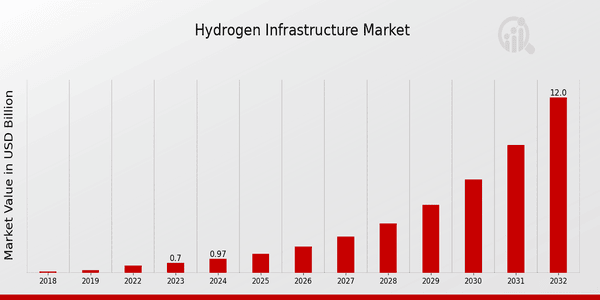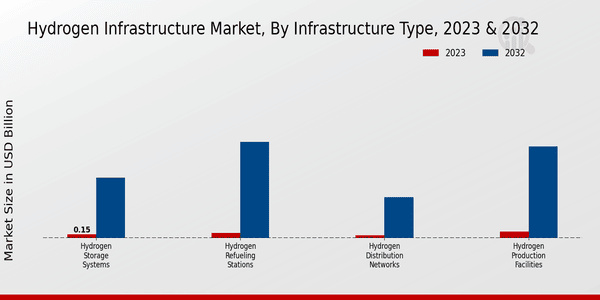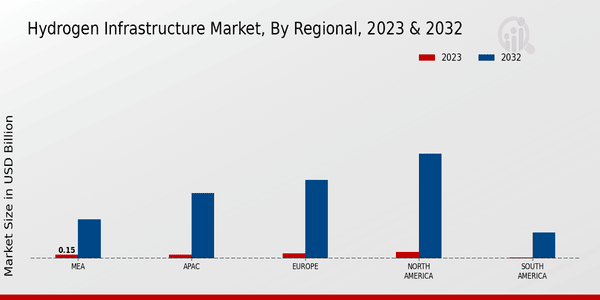Global Hydrogen Infrastructure Market Overview:
As per MRFR analysis, the Hydrogen Infrastructure Market Size was estimated at 0.51 (USD Billion) in 2022. The Hydrogen Infrastructure Market Industry is expected to grow from 0.7(USD Billion) in 2023 to 12.0 (USD Billion) by 2032. The Hydrogen Infrastructure Market CAGR (growth rate) is expected to be around 37.02% during the forecast period (2024 - 2032).
Key Hydrogen Infrastructure Market Trends Highlighted
The Hydrogen Infrastructure Market is primarily driven by an increasing focus on clean energy solutions to combat climate change and reduce dependence on fossil fuels. As governments and industries seek alternative energy sources, hydrogen has emerged as a versatile option for decarbonizing various sectors, including transportation, power generation, and industrial processes. Policies promoting renewable energy and investments in hydrogen technology infrastructure are further supporting this trend.
The growing awareness of the environmental implications of traditional energy sources enhances interest in hydrogen, making it an essential component of future energy strategies.Opportunities in the hydrogen infrastructure landscape are abundant, particularly in developing advanced storage techniques and distribution networks. There is also a significant potential for collaboration between private and public sectors to develop hydrogen fuel cell technology and hydrogen production facilities. As the importance of energy security escalates, regions rich in renewable resources, such as wind and solar, can leverage hydrogen as an energy carrier, allowing for greater energy independence. This necessitates investment in infrastructure, making it an opportune moment for stakeholders to explore new business models and partnerships.
Recent trends indicate a rising investment in hydrogen technologies alongside a noticeable shift toward more sustainable practices within various industries. Companies are increasingly recognizing the potential of hydrogen not just as an energy source but also as a means to enhance operational efficiency and reduce carbon footprints. There is growing interest in integrated hydrogen solutions that combine production, storage, and distribution, fostering innovation in the sector. The emergence of hydrogen hubs in strategic locations is also becoming a focal point, highlighting the need for collaboration across the supply chain to maximize efficiency and impact. As advancements continue to evolve, the hydrogen infrastructure market stands poised for significant growth and transformation.

Source: Primary Research, Secondary Research, MRFR Database and Analyst Review
Hydrogen Infrastructure Market Drivers
Rising Demand for Clean Energy Solutions
The increasing global emphasis on transitioning to cleaner energy sources to combat climate change is a primary driver for the Hydrogen Infrastructure Market Industry. As countries and industries strive to meet stringent emissions targets and pursue sustainability goals, hydrogen emerges as a key component in the decarbonization strategy.
The hydrogen economy is gaining momentum, fueled by governmental policies and incentives aimed at encouraging renewable energy adoption.Countries are investing heavily in research and development to harness the potential of hydrogen as a clean energy carrier. This involves setting up hydrogen production facilities and establishing the necessary infrastructure for the transportation, storage, and distribution of hydrogen. The demand for hydrogen fuel cells in various sectors, including transportation, industrial processes, and residential applications, is further propelling the market forward.
As more businesses and consumers recognize the benefits of hydrogen, the market is expected to witness unprecedented growth and expansion, making it a focal point in future energy strategies.
Government Initiatives and Policy Support
Government initiatives play a crucial role in the expansion of the Hydrogen Infrastructure Market Industry. Many governments worldwide are implementing supportive policies to encourage hydrogen infrastructure development, coupled with investments in research and projects aimed at promoting hydrogen as a viable energy solution. Subsidies, tax incentives, and funding for infrastructure projects significantly amplify the growth opportunities for market stakeholders. Nations are establishing national hydrogen strategies that include comprehensive plans to scale hydrogen production, distribution networks, and usage across various sectors, ultimately ensuring energy security and technological advancement.
Technological Advancements in Hydrogen Production
Technological advancements in hydrogen production methods are reshaping the Hydrogen Infrastructure Market Industry. Innovations such as electrolysis, which uses renewable energy to split water into hydrogen and oxygen, are becoming more efficient and cost-effective. As the production processes become more streamlined, the affordability and accessibility of hydrogen increase considerably. This, in turn, promotes widespread adoption across industries, driving more investments and enhancements in infrastructure like storage and distribution networks.The evolution and commercialization of new technologies are critical for the market's expansion and sustainability.
Hydrogen Infrastructure Market Segment Insights:
Hydrogen Infrastructure Market Infrastructure Type Insights
The Hydrogen Infrastructure Market, particularly focusing on the Infrastructure Type segment, showcases significant growth and valuation expected to reach 0.7 USD Billion in 2023 and further expand to 12.0 USD Billion by 2032. This strategic expansion reflects the increasing demand for green hydrogen solutions, spurred by transitioning energy policies and societal shifts towards sustainability. In terms of market segmentation, Hydrogen Production Facilities, Hydrogen Storage Systems, Hydrogen Distribution Networks, and Hydrogen Refueling Stations contribute distinctively to this growth trajectory.
Notably, Hydrogen Storage Systems, currently valued at 0.15 USD Billion in 2023, is projected to grow to 2.5 USD Billion by 2032. This segment plays a vital role in ensuring safe and efficient storage of hydrogen, a critical requirement for its effective use in various industries. Hydrogen Refueling Stations also show promising growth, starting at 0.2 USD Billion in 2023 and anticipated to escalate to 4.0 USD Billion by 2032, accentuating their significance in the transportation sector and promoting the shift to hydrogen fuel cell vehicles.Moreover, Hydrogen Distribution Networks, valued at 0.1 USD Billion in 2023, are expected to expand to 1.7 USD Billion by 2032, addressing the essential need for infrastructure that ensures the reliable delivery of hydrogen to consumers and industries alike. This segment is crucial in facilitating a seamless hydrogen supply chain.
Furthermore, Hydrogen Production Facilities, beginning with a valuation of 0.25 USD Billion in 2023 and projected to reach 3.8 USD Billion by 2032, dominate this sector as they are fundamental to the hydrogen supply chain, providing the necessary production capacity to meet growing market demands. The current trends show that the continuous development of efficient production methods, storage solutions, and distribution networks significantly contributes to the overall growth of the Hydrogen Infrastructure Market.A combination of regulatory support for clean energy initiatives, technological advancements in hydrogen generation, and increased investments in hydrogen infrastructure worldwide drives market growth.
However, challenges such as high initial investment costs, infrastructure requirements, and market uncertainties could potentially impede growth. Nevertheless, the industry's ability to adapt and innovate presents lucrative opportunities for stakeholders, reinforcing the importance of each segment, particularly Hydrogen Storage Systems and Hydrogen Refueling Stations within the Hydrogen Infrastructure Market revenue landscape. These segments not only support other infrastructures effectively but also provide the necessary foundation to accelerate the transition to hydrogen as a mainstream energy source, transforming the global energy market as it stands today.
Hence, understanding the detailed insights and dynamics of the Infrastructure Type segment sheds light on the comprehensive structure and prospects of the Hydrogen Infrastructure Market and its pivotal role in shaping a sustainable energy future.

Source: Primary Research, Secondary Research, MRFR Database and Analyst Review
Hydrogen Infrastructure Market Hydrogen Production Method Insights
The Hydrogen Production Method segment within the Hydrogen Infrastructure Market has gained significant traction, with the market valued at 0.7 billion USD in 2023, reflecting a growing interest in hydrogen as a clean energy source. This segment encompasses various methodologies, including Steam Methane Reforming, which remains a dominant player due to its efficiency and cost-effectiveness in producing hydrogen from natural gas. Electrolysis is also emerging as a crucial method, driven by technological advancements and the increasing use of renewable energy sources, making it vital for sustainable hydrogen production.
Gasification is recognized for converting carbon-rich materials into hydrogen and can leverage waste materials, contributing to circular economy efforts. Other Renewable Methods are gaining attention as the industry continues to explore diverse avenues for hydrogen production aimed at minimizing carbon footprints. As the Hydrogen Infrastructure Market segmentation evolves, the combination of these methods offers a robust foundation to meet the growing demand for hydrogen, highlighting the blend of traditional processes and innovative solutions essential for future energy landscapes.
Hydrogen Infrastructure Market End-Use Application Insights
The Hydrogen Infrastructure Market is experiencing notable growth, with an expected valuation of 0.7 billion USD in 2023 and anticipated expansion in the coming years. This market finds diverse applications across several sectors, including Transportation, Industrial Applications, Power Generation, and Residential and Commercial Heating. The Transportation segment plays a critical role, as hydrogen fuel cells are increasingly being adopted in vehicles, contributing to reduced emissions and improved efficiency. Industrial Applications represent a significant portion of hydrogen use, particularly in processes like metal refining and chemical production.
Power Generation is emerging as a vital area where hydrogen can provide cleaner energy solutions, addressing the demand for sustainable alternatives. Additionally, Residential and Commercial Heating applications are gaining prominence due to the shift towards low-carbon energy sources. The dynamic interplay of these segments shapes the overall Hydrogen Infrastructure Market statistics, driven by the need for cleaner energy solutions, energy security, and advancements in technology. As this sector evolves, it faces challenges such as infrastructure development and regulatory frameworks, yet opportunities abound for innovation and investment in robust hydrogen solutions.
Hydrogen Infrastructure Market Technology Insights
The Hydrogen Infrastructure Market is set to experience substantial growth in the Technology segment, with a market value of 0.7 USD Billion in 2023, expanding significantly to 12.0 USD Billion by 2032. The expected CAGR of 37.02 for the period 2024 to 2032 points to robust advancements and investments in hydrogen technologies. Within this market segmentation, Compressed Hydrogen plays a critical role as a reliable and efficient method for hydrogen storage and transportation, making it prominent in various applications. Liquid Hydrogen also figures prominently, particularly in sectors that require high energy density and are looking to scale hydrogen usage effectively.
Additionally, Hydrogen Carriers are becoming increasingly important due to their ability to facilitate long-distance transportation and storage of hydrogen, addressing logistical challenges. Trends like increasing government support, technological advancements, and the shift towards sustainable energy sources are driving growth in the Hydrogen Infrastructure Market. However, the industry faces challenges, such as infrastructure costs and the need for regulatory frameworks, which provide significant opportunities for innovation and development within the Technology segment.
Hydrogen Infrastructure Market Investment Type Insights
The Hydrogen Infrastructure Market revenue is set to experience substantial growth, with a valuation of 0.7 billion USD in 2023. Investment Type plays a crucial role in shaping this market, encompassing various avenues such as Public Sector Investment, Private Sector Investment, and Partnerships and Joint Ventures. Public sector investments are significant as they often provide vital funding and support for infrastructure projects driven by governmental policies aimed at promoting clean energy. Conversely, private sector investments are increasingly vital as they bring innovation and technological advancements to the hydrogen space, facilitating faster market growth.
Partnerships and Joint Ventures also dominate the landscape, as collaborations between industry players enhance resource sharing and risk management, which are crucial for developing this emerging market effectively. The interplay of these investment types not only supports the expanding scope of hydrogen infrastructure but also drives further engagement from both public and private entities, catering to the rising demand for sustainable energy solutions.
The market growth is underpinned by increasing awareness of the benefits of hydrogen as a clean energy carrier and aggressive governmental targets to decarbonize economies, highlighting significant opportunities ahead for all investment types in the Hydrogen Infrastructure Market industry.
Hydrogen Infrastructure Market Regional Insights
The Hydrogen Infrastructure Market is poised for significant growth within the Regional segment, showcasing diverse opportunities across various regions. In 2023, North America leads with a valuation of 0.25 USD Billion, reflecting its majority holding and commitment to developing hydrogen technology. Following closely, Europe holds a valuation of 0.20 USD Billion, characterized by robust policies supporting hydrogen adoption. Asia-Pacific and the Middle East Africa both stand at 0.15 USD Billion, indicating emerging interest and development in hydrogen infrastructure.
South America, at a lower valuation of 0.05 USD Billion, presents opportunities for growth as the region seeks sustainable energy solutions. By 2032, North America's expected valuation of 4.0 USD Billion suggests a dominant market position due to investment initiatives, while Europe's growth to 3.0 USD Billion indicates strong advancements in technology and infrastructure. The Asia-Pacific region shows promise, with a projected increase to 2.5 USD Billion, driven by industrial demand for cleaner energy. Overall, the Hydrogen Infrastructure Market statistics reflect a dynamic landscape, highlighting how each region responds to the global energy transition toward hydrogen solutions.

Source: Primary Research, Secondary Research, MRFR Database and Analyst Review
Hydrogen Infrastructure Market Key Players And Competitive Insights:
The Hydrogen Infrastructure Market is experiencing significant growth fueled by an increasing demand for cleaner energy solutions and the global emphasis on decarbonization. This evolving market landscape is characterized by a diverse array of players, ranging from traditional energy companies to innovative startups, all vying to establish a strong foothold in the hydrogen sector. Competitive insights reveal that companies are not only investing in the development of hydrogen production methods but are also expanding their efforts in hydrogen storage, distribution, and fueling stations. Key emerging trends include collaborations, partnerships, and initiatives aimed at building resilient hydrogen supply chains. Established firms are strategically enhancing their operational capability, thus intensifying competitive dynamics in the market.
Snam has emerged as a significant player in the Hydrogen Infrastructure Market, leveraging its extensive experience in energy infrastructure to support the transition to a hydrogen-based economy. The company's robust network of gas pipelines and storage facilities positions it favorably to facilitate the transportation and storage of hydrogen. Snam's strengths include its commitment to sustainability, showcasing its dedication to developing innovative technologies that enable hydrogen integration into existing infrastructures. Furthermore, the company actively engages in collaborations with various stakeholders, enhancing its competitive edge through shared expertise and resources. Snam's proactive approach to regulatory engagement and its investment in research and development contribute to its role as a pivotal entity in shaping the hydrogen landscape, ensuring that it remains at the forefront of this evolving sector.
Shell is another key contender in the Hydrogen Infrastructure Market, known for its extensive global reach and dedication to energy transition initiatives. The company is focusing on green hydrogen production, utilizing renewable energy sources to create sustainable hydrogen solutions. Shell's strengths lie in its longstanding expertise in energy systems, coupled with significant investments in infrastructure development for hydrogen production, distribution, and consumption.
The company is actively working on pilot projects and partnerships that facilitate the integration of hydrogen technologies into large-scale operations. Shell's commitment to a sustainable future is reflected in its innovative approaches and ambitious targets for reducing carbon emissions, positioning it strategically in the growing hydrogen market. Through these efforts, Shell aims to lead the transition towards a low-carbon economy, further solidifying its presence in the Hydrogen Infrastructure Market.
Key Companies in the Hydrogen Infrastructure Market Include:
- Snam
- Shell
- Air Liquide
- Nel ASA
- ITM Power
- Siemens Energy
- Linde
- TotalEnergies
- Ballard Power Systems
- Bloom Energy
- Hydrogenics
- Gaz de France
- Plug Power
- McPhy Energy
- Thyssenkrupp
Hydrogen Infrastructure Market Industry Developments
Recent developments in the Hydrogen Infrastructure Market underscore its rapid ascent as a key player in the renewable energy landscape. Major economies are significantly increasing investments in hydrogen production, storage, and distribution technologies, driven by the dual imperatives of decarbonization and energy security. Nations are announcing ambitious hydrogen strategies, with a focus on green hydrogen derived from renewable sources, showcasing a shift from traditional fossil-based methods. Partnerships between governments and private sectors are becoming commonplace, aiming to develop hydrogen hubs and enhance supply chain logistics.
Furthermore, technological advancements in electrolyzers and fuel cells are projected to lower costs and improve efficiency, facilitating broader adoption across various sectors such as transportation and industrial applications. With a projected market valuation of 12.0 billion USD by 2032 and a substantial compound annual growth rate, the hydrogen infrastructure market is positioned for transformative growth, supported by regulatory frameworks and international collaborations focusing on sustainable energy solutions. This momentum reflects a growing recognition of hydrogen as a versatile energy carrier essential for achieving global climate goals.
Hydrogen Infrastructure Market Segmentation Insights
- Hydrogen Infrastructure Market Infrastructure Type Outlook
- Hydrogen Production Facilities
- Hydrogen Storage Systems
- Hydrogen Distribution Networks
- Hydrogen Refueling Stations
- Hydrogen Infrastructure Market Hydrogen Production Method Outlook
- Steam Methane Reforming
- Electrolysis
- Gasification
- Other Renewable Methods
- Hydrogen Infrastructure Market End Use Application Outlook
- Transportation
- Industrial Applications
- Power Generation
- Residential and Commercial Heating
- Hydrogen Infrastructure Market Technology Outlook
- Compressed Hydrogen
- Liquid Hydrogen
- Hydrogen Carriers
- Hydrogen Infrastructure Market Investment Type Outlook
- Public Sector Investment
- Private Sector Investment
- Partnerships and Joint Ventures
- Hydrogen Infrastructure Market Regional Outlook
- North America
- Europe
- South America
- Asia Pacific
- Middle East and Africa
| Report Attribute/Metric |
Details |
| Market Size 2022 |
0.51(USD Billion) |
| Market Size 2023 |
0.7(USD Billion) |
| Market Size 2032 |
12.0(USD Billion) |
| Compound Annual Growth Rate (CAGR) |
37.02% (2024 - 2032) |
| Report Coverage |
Revenue Forecast, Competitive Landscape, Growth Factors, and Trends |
| Base Year |
2023 |
| Market Forecast Period |
2024 - 2032 |
| Historical Data |
2019 - 2022 |
| Market Forecast Units |
USD Billion |
| Key Companies Profiled |
Snam, Shell, Air Liquide, Nel ASA, ITM Power, Siemens Energy, Linde, TotalEnergies, Ballard Power Systems, Bloom Energy, Hydrogenics, gaz de France, Plug Power, McPhy Energy, Thyssenkrupp |
| Segments Covered |
Infrastructure Type, Hydrogen Production Method, End Use Application, Technology, Investment Type, Regional |
| Key Market Opportunities |
1. Increased governmental support initiatives 2. Expansion of hydrogen fuel cell technologies 3. Development of hydrogen production facilities 4. Integration with renewable energy sources 5. Growth in the transport and logistics sector |
| Key Market Dynamics |
1. Growing renewable energy adoption 2. Government regulations and incentives 3. Technological advancements in hydrogen production 4. Increasing demand for clean energy 5. Expanding hydrogen transport and storage infrastructure |
| Countries Covered |
North America, Europe, APAC, South America, MEA |
Frequently Asked Questions (FAQ) :
The Hydrogen Infrastructure Market is expected to be valued at 12.0 USD Billion in 2032.
The projected CAGR for the Hydrogen Infrastructure Market from 2024 to 2032 is 37.02%.
North America is expected to have the largest market share, valued at 4.0 USD Billion in 2032.
The market size for Hydrogen Production Facilities is expected to reach 3.8 USD Billion in 2032.
Major competitors in the Hydrogen Infrastructure Market include players like Snam, Shell, and Air Liquide.
Hydrogen Refueling Stations are projected to be valued at 4.0 USD Billion in 2032.
The Hydrogen Storage Systems segment is expected to grow to 2.5 USD Billion by 2032.
Hydrogen Distribution Networks are expected to reach a market size of 1.7 USD Billion in 2032.
The projected market value in Europe is expected to reach 3.0 USD Billion by 2032.
The market faces challenges including regulatory hurdles and the high cost of infrastructure development.





























